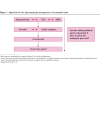Pharmacologic management of chronic neuropathic pain: Review of the Canadian Pain Society consensus statement
- PMID: 29138154
- PMCID: PMC5685445
Pharmacologic management of chronic neuropathic pain: Review of the Canadian Pain Society consensus statement
Abstract
Objective: To provide family physicians with a practical clinical summary of the Canadian Pain Society (CPS) revised consensus statement on the pharmacologic management of neuropathic pain.
Quality of evidence: A multidisciplinary interest group within the CPS conducted a systematic review of the literature on the current treatments of neuropathic pain in drafting the revised consensus statement.
Main message: Gabapentinoids, tricyclic antidepressants, and serotonin-norepinephrine reuptake inhibitors are the first-line agents for treating neuropathic pain. Tramadol and other opioids are recommended as second-line agents, while cannabinoids are newly recommended as third-line agents. Other anticonvulsants, methadone, tapentadol, topical lidocaine, and botulinum toxin are recommended as fourth-line agents.
Conclusion: Many pharmacologic analgesics exist for the treatment of neuropathic pain. Through evidence-based recommendations, the CPS revised consensus statement helps guide family physicians in the management of patients with neuropathic pain.
Objectif: Offrir aux médecins de famille un résumé clinique pratique de la déclaration consensuelle révisée de la Société canadienne de la douleur (SCD) sur la prise en charge pharmacologique de la douleur neuropathique.
Qualité de l’information: Un groupe d’intérêt multidisciplinaire au sein de la SCD a effectué une revue systématique des ouvrages scientifiques sur les traitements actuels de la douleur neuropathique dans le contexte de la rédaction d’une déclaration consensuelle révisée.
Message principal: Les gabapentinoïdes, les antidépresseurs tricycliques, et les inhibiteurs de la recapture de la sérotonine et de la noradrénaline sont les agents de première intention pour traiter la douleur neuropathique. Le tramadol et les autres opioïdes sont recommandés comme agents de deuxième intention, tandis que les cannabinoïdes sont recommandés depuis peu comme agents de troisième intention. D’autres anticonvulsivants – la méthadone, le tapentadol, la lidocaïne topique et la toxine botulique – sont recommandés comme agents de quatrième intention.
Conclusion: Il existe de nombreux analgésiques pharmacologiques pour le traitement de la douleur neuropathique. Par ses recommandations fondées sur des données probantes, la déclaration consensuelle révisée de la SCD aide à orienter les médecins de famille dans la prise en charge des patients souffrant de douleur neuropathique.
Copyright© the College of Family Physicians of Canada.
Figures

Comment in
-
Composition of Canadian Pain Society guideline development group?Can Fam Physician. 2018 Jan;64(1):8. Can Fam Physician. 2018. PMID: 29358240 Free PMC article. No abstract available.
-
Nortriptyline safer than amitriptyline?Can Fam Physician. 2018 Sep;64(9):634-636. Can Fam Physician. 2018. PMID: 30209089 Free PMC article. No abstract available.
References
-
- Foley KM. Opioids and chronic neuropathic pain. N Engl J Med. 2003;348(13):1279–81. - PubMed
-
- Bouhassira D, Lantéri-Minet M, Attal N, Laurent B, Touboul C. Prevalence of chronic pain with neuropathic characteristics in the general population. Pain. 2008;136(3):380–7. Epub 2007 Sep 20. - PubMed
-
- Torrance N, Smith BH, Watson MC, Bennett MI. Medication and treatment use in primary care patients with chronic pain of predominantly neuropathic origin. Fam Pract. 2007;24(5):481–5. Epub 2007 Aug 1. - PubMed
-
- Kautio AL, Haanpää M, Kautiainen H, Kalso E, Saarto T. Burden of chemotherapy-induced neuropathy—a cross-sectional study. Support Care Cancer. 2011;19(12):1991–6. Epub 2010 Nov 16. - PubMed
Publication types
MeSH terms
Substances
LinkOut - more resources
Full Text Sources
Medical
Research Materials
